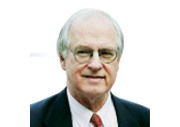Under ‘guidance’ in N. Korea
PYONGYANG – You don’t come here looking for news about North Korea. On the day after “Respected Leader” (that’s what we’re supposed to call him) Kim Jong-un and his mystery lady attended a show featuring Walt Disney characters on stage, our minders were fonts of ignorance. They professed to know nothing about an event we’d seen reported by BBC on TV sets in the luxury hotels for foreign guests.
You’re so tightly controlled in North Korea you have a hard time finding real non-news, that is, soft stuff that gives a clue as to what’s going on. On my latest visit, I’ve now seen the home where Kim Il-sung spent his childhood for the fifth time. I’ve traipsed for the third time through the Fatherland Liberation War Museum, and I’ve been to the Juche Tower looming high above the Daedong River three or four times ― I don’t think it was completed during my first visit here 20 years ago.
Oh, and no visit would be complete without a look around the Pueblo, the U.S. spy ship captured off the east coast in 1968. When I first saw the Pueblo in 1995, it was moored at Wonsan, but North Korean sailors a few years later got it around the Korean peninsula all the way to the west coast port of Nampo and up the Daedong to Pyongyang.
A North Korean guide once told me the Pueblo eluded American surveillance on the journey after sailors removed communications gear sticking above and covered the sorry old tub with canvas to make it look like an aging cargo vessel, which is what it was before the U.S. navy converted it.
Nor is the routine of jumping in and out of a tour bus to gaze on points of national pride the only hazard. The real problem is the omnipresence of the guides who know how to be pleasant when leading you in and around the sights but totally tough when duty calls. They forbid you from photographing anything that might be construed as embarrassing or sensitive or, of course, “secret” and won’t let anyone talk to ordinary citizens at all.
We can’t help but see that most people, having not had enough to eat since birth, are thin, thinner probably outside Pyongyang. More so now than when I was last here four years ago, the rich-poor gap divides Pyongyang from the rest of the country. The quality of life in Pyongyang, population 3 million, may be marginally better than in my previous visits – how much better is far from clear – while the pace elsewhere seems hardly to have changed.
Our tour bus gets caught in occasional traffic jams in Pyongyang, a new phenomenon, but in the countryside we cruise mostly alone over buckling highways past pastoral scenes and over and through mountains often bereft of trees. We see only occasional trains running along tracks in need of repair while “volunteers,” often women and kids, bang away at stones for the roadbeds.
In more crowded regions, people ride or push bicycles, oxen pull carts, and wood-burning trucks emit thick black smoke from what look like large stoves in the open cargo sections. Our guides ban photographs of those wood-burners ― they’re seen not as a bit of local color but as a national embarrassment and are banned from Pyongyang.
A visit to the country’s largest industrial center and second largest city, Hamheung near the east coast, reveals decaying factories and decrepit apartments. Recently open to occasional visitors, Hamheung, population 800,000, is still struggling after having been hard hit during and after the worst famine in the 1990s. One of its products is a fabric called vinalon, made from limestone, but guides don’t want anyone photographing the vinalon factory either ― whether because of the odd nature of the product or the sorry state of the machinery, we have no clue.
We snap away unmolested, however, at gardens of corn and veggies growing up to the walls of houses, many of which seem to be made of hardened clay, not cement. Millions of families rely on these small plots to feed themselves and sell a little on nearby markets. State cooperatives provide most of the food, rewarding work teams depending on their output, meaning the whole team suffers when crops are bad. Oxen, not tractors pull almost all the ploughs, and the country still needs huge imports from China to fend off starvation.
While the elite of Pyongyang get just enough to eat, Kim Jong-un, clearly overweight, smiles for state TV during visits to farms, factories, amusement parks and military units. He may project a slightly more pleasant image than his father, Kim Jong-il, on television, but the campaign to build him up hardly disguises the reality that North Korea remains woefully short of fuel, food and all else.
Signs and inscriptions commemorating visits by “Respected” Kim Jong-un’s dynastic predecessors, grandfather and “President” Kim Il-sung and father “General” Kim Jong-il (those are the titles our guides keep using) are much in evidence. Gazing on museums and monuments venerating “Eternal President” Kim Il-sung, the new leader’s grandfather, we wonder how or if life can go on as before the death of Kim Jong-il.
You won’t get answers to such questions on a guided tour, but in a country and society mired in the past and going nowhere, you have to think something has to break some day. How or when remains as much a mystery now as when I ventured here in 1992. <The Korea Times/Donald Kirk>



